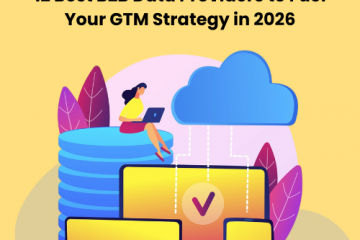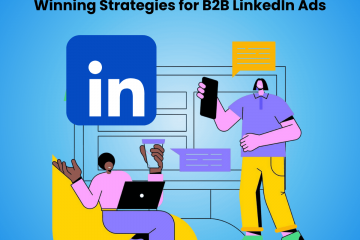Cookieless Marketing in 2025: Strategies and Tools for a Privacy-First World
The future is cookieless! No, we don’t mean actual cookies. We are talking about digital cookies—the little snippets of code marketers can use to track user behaviors once they visit a certain website—specifically, third-party cookies. But what does this mean?

Most web browsers are phasing out the usage of third-party cookies because of the unambiguous nature of data tracking these little snippets of code enable, allowing digital advertising companies like Meta and Google to target consumers more precisely with their ads.
Ever had a Facebook or a Google ad advertise the same kind of product you were browsing for on another website after a couple of days? Yes, that’s third-party cookies working their magic. Here’s the snag, though—many consumers do not appreciate being “followed” around the web, especially without informed consent. Moreover, there has been a significant increase in online data breaches in recent years, leading to malicious parties gaining control over personal data, thus eroding consumers’ trust in major brands.
Owing to these reasons, the death of third-party cookies is imminent, and from its ashes, we expect cookieless marketing to arise! But how can marketers prepare for a privacy-first world where traditional approaches of data tracking using third-party cookies will cease to exist?
In this blog, we will be discussing the implications of a cookieless future, including what B2B marketers can do to prepare for it and the strategies and tools they need to adapt to and equip themselves with to thrive with cookieless marketing. Let’s get into it now!

Before discussing cookieless marketing, we want to provide you with a better understanding of why third-party cookies are being phased out.
The main reason is the increasing number of online data breaches and the consequent implementation of data privacy regulations like the EU’s General Data Privacy Regulation (GDPR), which clearly outline the necessary legal bases for companies collecting personal data.
In light of this, third-party cookies, while an invaluable asset for digital marketers not so long ago, do not offer much transparency when it comes to consumers’ choice and control over how their personal data is being processed and used all over the Internet
This is why web browsers like Safari and Firefox have long since blocked third-party cookies.
Google is the latest to join this quest, given it is the largest advertising network in the world, and while they have currently paused the endeavour to phase out third-party cookies completely, they are shifting their focus to an updated approach to privacy-preserving user tracking that “elevates user choice”.
![]()
Here is what Anthony Chavez, Google’s Vice President of Privacy Sandbox, shared in a recent blog post:
“Instead of deprecating third-party cookies, we would introduce a new experience in Chrome that lets people make an informed choice that applies across their web browsing, and they could adjust that choice at any time. We’re discussing this new path with regulators, and will engage with the industry as we roll this out.”
This is all to say that the era of unambiguous cookie tracking is over, and the future belongs to marketers who adapt their strategies to focus on cookieless marketing.
Cookieless marketing is a form of advertising that does not rely on third-party cookies to track user behavior. It is a set of advertising measures primarily developed due to the death of third-party cookies out of privacy considerations.
Cookieless marketing uses first-party data obtained directly from users with their express consent, contextual advertisements that target content rather than individual behavior, and other privacy-focused technologies, including Google’s Privacy Sandbox.
![]()
The approach is based on transparency and user trust, allowing compliance with privacy regulations like the GDPR and the CCPA. With an emphasis on consented data and contextual relevance, cookieless marketing will enable companies to run a successful advertising program that respects user privacy and appropriately adjusts to the changing digital landscape.
So, how can B2B marketers prepare for the cookieless future? We have outlined a three-step process below that can help you become independent of third-party cookies and still gain valuable insights into your target prospects for advertising success.
Follow the three steps outlined below to prepare for the cookieless marketing future:
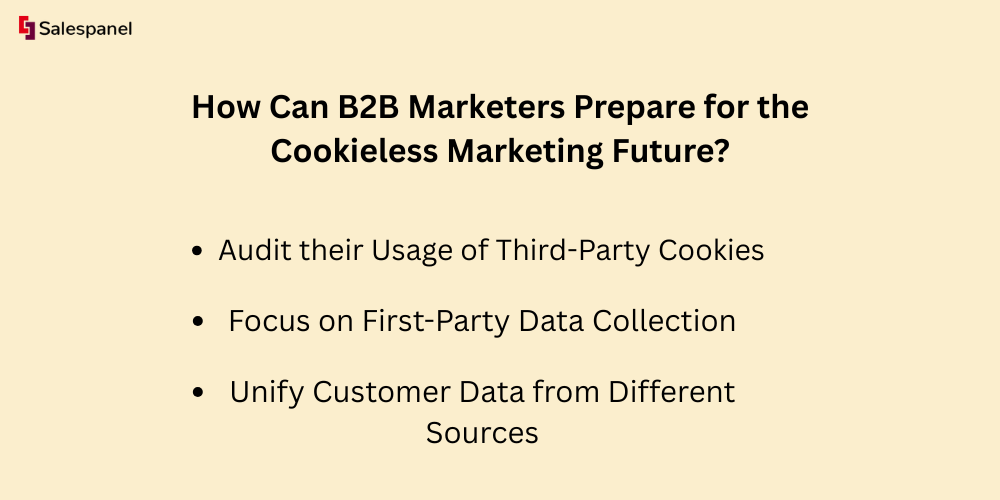
For starters, B2B marketers should assess their dependence on third-party cookies. They should systematically identify the activities, tools, and platforms where these are used and estimate the impact their removal would have on the effectiveness of those resources.
This audit will guide marketers in identifying priority areas for possible retargeting or audience segmentation adaptations. Leveraging this understanding can enable marketers to plan a gradual changeover from dependence on third-party cookies to other alternatives while minimising disruption to their marketing muscles.
Focus on First-Party Data Collection
Following the death of third-party cookies, marketers need to shift their focus to zero- and first-party data. These data types are either provided by customers (through surveys) or collected by businesses using their own methods (such as tracking user behaviors).
Here are some sources you can collect zero- and first-party data from:
- Website Forms: This refers to collecting information through gated content, newsletters, or demo requests
- CRM Systems: This involves the use of any data collected on customer interactions and transactions. Surveys: This is where you get some insights directly from your customers
- Loyalty Programs: This is where you encourage your customers to share data in exchange for rewards
- Behavioural Tracking: This involves using a privacy-compliant tool, particularly server-side tracking.
For example, you can use Salespanel’s Deep Tracking feature, a privacy-focused tool designed with the cookieless future in mind, to track customer journeys across multiple domains, while adhering to privacy and data regulations. Establishing trust and transparency in the data collection process enables compliance and furthers strong customer relationships.
Unify Customer Data from Different Sources
Marketers struggle to access customers’ data because almost all such data is scattered everywhere. Consumer data is typically found in various sources; these include analytics tools, content management systems, SMS, emails, and CRMs. This leads to data silos that deprive marketers of a holistic view of the customer journey.
This is where solutions such as customer data platforms (CDPs) and data management platforms (DMPs) come in. Unified data allows for personalised marketing and ensures privacy. By eradicating data silos, B2B marketers can deliver a consistent, targeted experience across channels, enhancing engagement and driving conversions in a cookieless future.
Transitioning to cookieless marketing requires a deep contextual understanding of users’ search intent and behaviors, without depending on third-party cookies. This can include several different strategies, but you can start with the ones highlighted below:
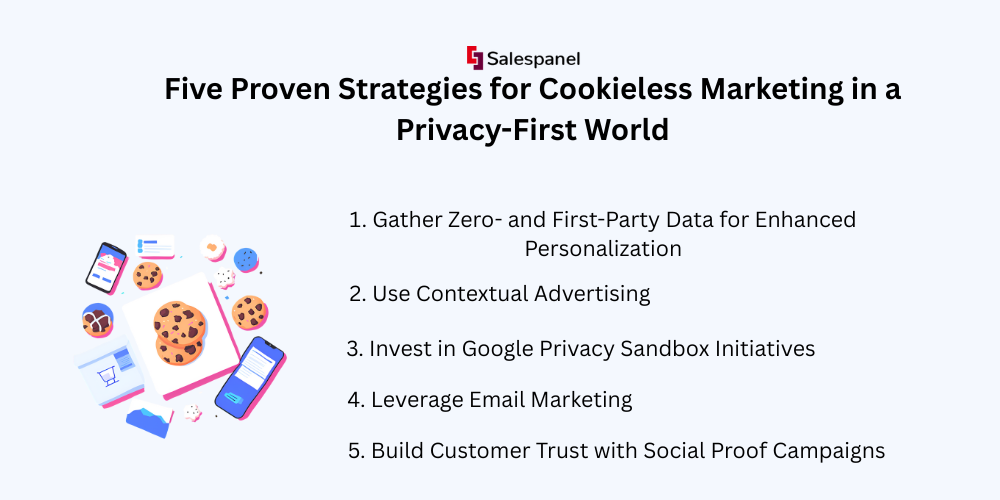
1. Gather Zero- and First-Party Data for Enhanced Personalization
Zero-party data (information explicitly shared by users) and first-party data (information collected directly from user interactions) are by far the best means of customizing ad campaigns in the cookieless world. Such information is direct and clean, and is precluded from any third-party involvement, meaning you can collect it without triggering any privacy guidelines.
Zero-party data is gathered through forms and surveys on the website. In contrast, first-party data is collected from customer service calls with calling systems, customer relationship management systems, website analytics platforms, e-mail marketing campaigns, etc.
![]()
Thus, brands can use zero- and first-party data to create hyper-personalized customer experiences without relying on third-party cookies. Since users themselves provide such data, it can ensure adherence to privacy norms while enabling personalized experiences.
Note: Other important forms of first-party data can also be collected from vanity URLs, subdomains, and country-specific domains, which can be most helpful in PPC campaigns where landing pages might be hosted outside your main domain.
2. Use Contextual Advertising
Instead of employing third-party cookies as nosy middlemen, marketers can now use contextual advertising to target users based on the content they are currently engaged in.
With this approach, ads can be placed in the context of the page, video, or app for relevance to the user without compromising their privacy. For instance, a person reading an article on hiking trails could be shown ads for outdoor gear or travel destinations.
Contextual advertising uses algorithms to assess content (such as keywords, themes, and topics) and pair it with suitable ads, thus conforming to privacy regulations such as GDPR. This presents benefits such as more relevant ad placements aligned with the viewer’s interests and brand safety since advertisers can ensure their ads appear alongside appropriate content.
Contextual marketing allows advertisers to maximize the efficiency of their campaigns by real-time testing and optimization based on real-time clicks and conversions metrics. Thus, contextual ads can effectively reach audiences in a cookieless future since they’ve been staring at context rather than individuals.
3. Invest in Google Privacy Sandbox Initiatives
Google’s Privacy Sandbox is intended to replace third-party cookies with privacy-preserving technologies like the Topics API for interest-based advertising.
![]()
While it is still under development, Google’s Privacy Sandbox initiatives will be a game-changer for marketers in a cookieless era. So, what kind of privacy-preserving functions can you expect?
One example is the FLoC (the Federated Learning of Cohorts) proposal. FLoC groups users into cohorts based on their web activities, allowing advertisers to target groups rather than individuals. This approach maintains ad relevance while minimizing data exposure.
By adopting these initiatives early, marketers can stay ahead of industry changes, ensure compliance with evolving privacy constraints like the GDPR, and continue to target advertising audiences more effectively. Moreover, the Sandbox trials will allow marketers to see how these technologies operate in real-world scenarios, allowing businesses to refine their strategies.
Thus, investing in Google’s Privacy Sandbox initiatives ensures that marketing moves into the future with proof of concern for users’ privacy that can improve customers’ trust and help the business maintain a competitive edge in a cookieless world.
4. Leverage Email Marketing
Email marketing is yet another privacy-compliant strategy for cookieless marketing, enabling a business to build direct relationships with potential customers. Since companies can collect emails by sign-up, purchase, or lead magnets, they can now directly address customers through personalization without relying on third-party cookies.
For example, a project management SaaS tool can send targeted emails to users based on their usage patterns, such as tips for optimizing workflows or reminders about underutilized features, thus driving subscription renewals and upsells.
Email marketing also provides segmentation and automation—hitting customers with the right message at the right time, thus creating a personalized experience that feels relevant and meaningful. Moreover, email campaigns are measurable, with metrics like open rates, click-through rates, and conversions, which make it easy to test marketing strategies over time.
Thus, companies can use email marketing to improve customer experience by reinvesting in exclusive deals, offering educational tips, and personalizing communications—all while keeping regulations like GDPR in mind, ultimately boosting long-term success in a cookieless world.
Customer testimonials are a goldmine for zero-party data. For instance, say a customer shares a review expressing appreciation for some features of your product and highlights some areas for improvement. This can directly influence your product innovation and marketing strategies without needing to reference any external data.
Customer reviews and testimonials can be utilized in ad campaigns as social proof that cultivates trust and credibility among potential clients. User ratings on your landing page can build confidence in product effectiveness, while case studies displaying specific metrics, such as cost savings, can endorse your product’s value.

Image Source: www.Bluleadz.com
Furthermore, social proof campaigns can convert user-generated content into a medium for strengthening authenticity and symbolizing actual experiences and results. You can focus away from targeted advertising and build more organic and genuine associations with possible customers. This is a powerful approach for cookieless marketing.
Now that you are familiar with cookieless marketing strategies, let’s examine the tools you can use to enhance your cookieless advertising success.
Here are five tools that help you work with first-party data and activate your cookieless marketing strategies:

Salespanel
Salespanel aims to equip marketers with unique insights into product interactions during their buying journey. But how?
Salespanel offers a feature called Deep Tracking, which creates a unique ID for every visitor. This makes the software immune to cookie blockers, thus, allowing user activities to be tracked even on browsers and CMSes that have eliminated support for front-end cookies.
Here are some key benefits of using Salespanel’s Deep Tracking feature:
- First-Party Focus Data: Deep Tracking uses first-party cookies plus unique identifiers, extracting data directly from the website with user consent.
- Cross-Domain Tracking: Deep Tracking can also track user activities across domains, allowing for a better sense and understanding of the customer journey.
- Adaptive to Browser Changes: Deep Tracking is resilient to browser changes since it doesn’t rely solely on cookies.
- Highly Accurate: Deep Tracking further allows precise tracking of a user’s actions through unique visitor IDs, enabling more effective and targeted marketing campaigns.

You can go completely cookieless with Salespanel’s Deep Tracking option, although we recommend enabling cookies along with it so you complement the best of both worlds and consequently better capture your customer’s journey. Salespanel has also implemented a server-side tracking setup wherein user tracking can be further enabled only after consent has been sought, ensuring compliance with privacy laws and making it all the more reliable.
Google Analytics 4
Google has been steadily adding privacy-focused features to its tool stack in an attempt to support ethical advertising practices, and the new features in Google Analytics 4 are prime examples of this. GA4 is built on privacy-first principles and designed to help marketers navigate the cookieless future by focusing on privacy-centric data collection.
Here are the key features of Google Analytics 4 for cookieless marketing:
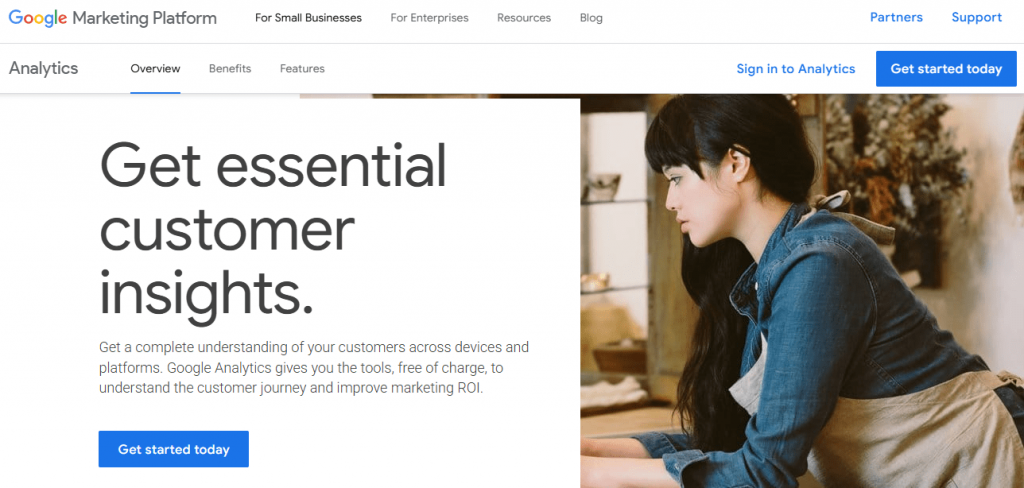
- Event-Based Tracking: GA4’s event-based tracking replaces session-based tracking so marketers can track interactions such as clicks and video views across sites and apps without cookies. Custom events could also provide granular insights into user behaviors.
- Enhanced Privacy Controls: GA4 prioritizes privacy with IP anonymization and consent mode to comply with GDPR and CCPA. It enables businesses to conditionally collect data based on user consent for ethical marketing analytics.
- AI-Powered Predictive Insights: GA4 allows marketers to forecast user behaviors, including likelihood to purchase and churn, without requiring direct tracking. These features eliminate the need for reliance on third-party cookies.
- Cross-Platform Tracking: GA4 can effectively track user interactions across websites, apps, and devices using first-party and modeled data. This approach helps marketers understand the complete customer journey without needing third-party cookies.
HubSpot CRM
Need a CRM platform focused on consent-based interactions and owned data? Look no further than HubSpot CRM.
HubSpot CRM champions the collection of first-party data and managing customer relations to allow marketers to customize and run their campaigns with full awareness of privacy without the aid of external cookies. Here are four key features of HubSpot CRM for cookieless marketing:

- First-Party Data Collection: HubSpot CRM allows businesses to gather first-party data directly from customers, through forms, chatbots, emails, and website interactions.
- Consent Management: HubSpot CRM is designed to allow consumer consent and preference management. It ensures that its privacy policies align with government regulatory bodies, such as the GDPR while keeping personalization efforts.
- Customer Segmentation: HubSpot CRM further offers features to segment customers based on their behaviors, preferences, and engagement and build full user profiles, thereby helping marketers plan their campaigns without relying on third-party options.
- Seamless Integration with Ad Platforms: HubSpot’s integration allows marketers to tap into first-party data alongside contextual and intent-based tightly connected campaigns through Google Ads, Facebook Ads, and LinkedIn Ads.
LiveRamp
LiveRamp is a top-tier data connectivity platform that allows brands to implement cookieless marketing strategies while still engaging customers in a personalized and privacy-compliant manner. This software provides identity resolution and data onboarding solutions so that businesses can connect first-party data across multiple channels and set targeted marketing campaigns. Here are four key features of LiveRamp for cookieless marketing:
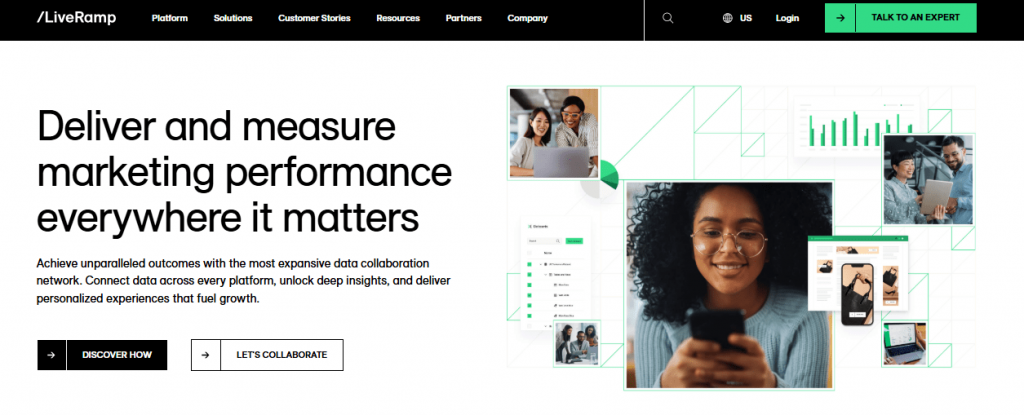
- Identity Resolution: Using its innovative IdentityLink technology, LiveRamp activates Customer ID systems built on anonymous identifiers so businesses can remain focused on their customers despite not using cookies.
- Privacy-Centric Data Collaboration: LiveRamp connects brands to share and build on enriched first-party data with their trusted partners in a clean, secure environment. This allows for deeper audience insights while avoiding fragile privacy waters.
- Authenticated Traffic Solution (ATS): LiveRamp’s ATS is, in effect, a way for publishers and advertisers to leverage encrypted first-party data to connect user identities from logins and allow personalized advertising in a cookieless environment.
- People-Based Targeting: With its pro-people approach, marketers can connect to audiences using LiveRamp across devices and platforms through deterministic identification rather than probabilistic tracking.
Permutive
Permutive is a leading privacy-first marketing tool designed to help publishers and advertisers navigate the cookieless era by leveraging first-party data and privacy-compliant strategies. It enables real-time data processing and activation, helping businesses build targeted campaigns, while ensuring compliance with rapidly changing privacy regulations like GDPR and CCPA. Here are four key features of Permutive for cookieless marketing:
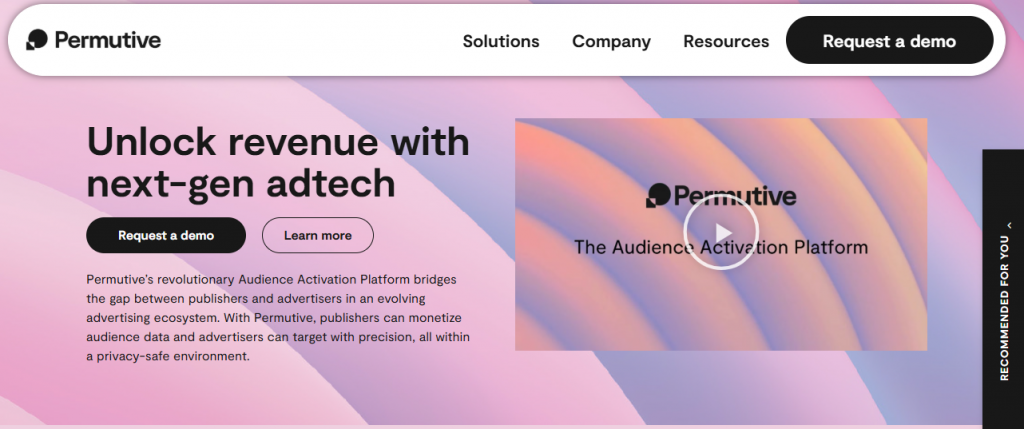
- First-Party Data Activation: Permutive helps businesses to collect first-party data from their audiences neatly, thus enabling marketers to build and target audience segments without the need of third-party tracking
- Contextual Advertising: Permutive empowers advertisers to target contextual rather than behavioral and make ads relevant without tracking users.
- Scalable Data Activation: Permutive ensures seamless integration with leading DSPs and ad exchanges, enabling businesses to scale their cookieless campaigns efficiently.
- On-Device Processing for Privacy Compliance: Permutive processes all data on the user´s device to efficiently empower precise targeting while complying with the most modern privacy regulations, including GDPR and CCPA.
Final Thoughts
As privacy guidelines tighten and internet users restrict third-party cookie access and block ads from major advertisers, marketers must find ways to acquire customer data with users’ consent to win in a privacy-focused world. The future of marketing is cookieless and businesses must respect user privacy while still personalizing their ad campaigns to target potential customers.
This is where zero- and first-party data come in. Collecting such data and extracting valuable insights from such sources is the best way to ensure advertising success in a cookieless world. We hope the strategies highlighted in the blog help you with cookieless marketing. Besides this, we also recommend using Salespanel to track user interactions throughout your customers’ journeys and leverage the data to inform your B2B advertising campaigns. Ready to supercharge your cookieless marketing efforts for the future? Check out Salespanel today!
Sell more, understand your customers’ journey for free!
Sales and Marketing teams spend millions of dollars to bring visitors to your website. But do you track your customer’s journey? Do you know who buys and why?
Around 8% of your website traffic will sign up on your lead forms. What happens to the other 92% of your traffic? Can you identify your visiting accounts? Can you engage and retarget your qualified visitors even if they are not identified?
